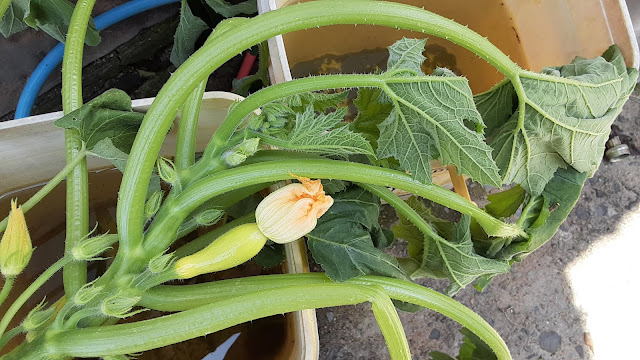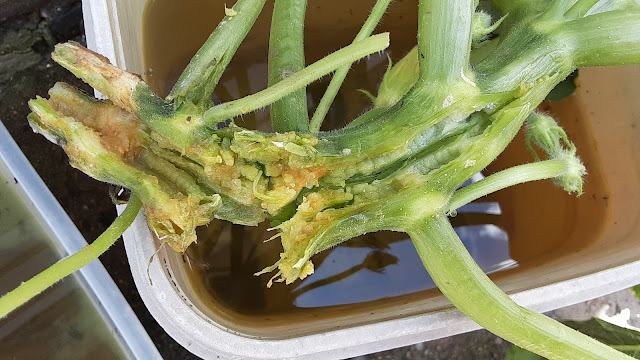This past summer was, as my little sister said, a "mean summer."
I suppose that's not unusual though. I can remember as a kid scanning the intense blue summer sky for clouds and just wishing so hard that it would rain. School would start in August, and the afternoon rides home on the un-air-conditioned bus were sweltering hot, even with every window on the bus down.
But eventually the weather would break, the daytime temperatures would return to at least bareable and the rains would return.
We made it to that "end of summer" weather for 2025. After what I suspect will be yet another hot/dry - probably record hot yet again - finally we got some slightly cooler temperatures and some much needed rain in late August and mid-September. It was still hot out in the sun during the afternoons, anywhere from mid-80s to low 90s, but the nighttime temperatures were much cooler and the forecast showed highs in the upper 70s in the coming days.
So what happened in The Meadow over the summer?
In mid-June, the weedy-looking mess gave me a little glimpse of what I hope will be its future beauty.
 |
| The meadow, on June 19 of its first year. |
Some of the highlights:
 |
| Spotted Bee Balm (Monarda punctata) |
Black-eyed Susan (Rudbeckia hirta). To the right, there's a flower stalk and bud of one of the pale purple coneflowers.
 |
| Purple Love Grass (Eragrostis pectinacea). Sadly, these two clumps didn't survive the summer. |
 |
| Tall Thistle (Cirsium altissimum) |
 |
| Splitbeard Bluestem (Andropogon ternarius), surrounded by what I believe was crab grass. |
 |
| Plains Coreposis (Coreopsis tinctoria) rescued from the Sparks place, just starting to bloom. |
There really weren't very many plants that bloomed in this first summer, but they had all started to grow, and it looked like they were going to be Ok.
I had a few pots of pale purple coneflower (Echinacea pallida - or maybe it's Echinacea simulata? I'm not sure....) that I had winter sown and as spring turned to summer, they were really starting to outgrow their pots. Rather than move them into larger pots, I decided to go ahead set them out.
I had also planted some splitbeard bluestem seeds in one of my 9-pack module trays. The seeds germinated, but I couldn't seem to keep them watered and several of them died. I decided to just plant the survivors in the meadow as well.
July and August are horrible months to set out transplants, but since I had gone and done it, I decided to cover the little patch of meadow with one of my 40% garden shade cloths to try protect them at least a little bit from the baking hot summer sun.
Boy, did it look tacky! But it actually worked really well. With just a little of the sunlight blocked from hitting them, most of the transplants survived.
The end of summer saw the fall bloomers take center stage. The late boneset was blooming, the wrinkleleaf goldenrod was blooming, and the Texas vervain, plains coreopsis and Rudbeckia hirta put out a second flush of flowers. I was reminded why I wanted a meadow in the first place.
After setting out the transplants, I hadn't planned on doing any more work in The Meadow this year.
But fools are called fools for a reason, I suppose.
RAF came out one Saturday in September to find me dragging the silage tarp over a new section of the field. He watched for a bit and when I stopped to ask him what he thought he said, "I just don't get it. You haven't even finished the first part yet and you're making it bigger????"
He does have a point. But because the tarp has to be down for about a year to kill the Bermuda grass, I guess I was getting anxious.
After the billboard tarp and all but one piece of the silage tarp was moved, I took my weeding sickle and worked around the entire edge of where the tarp had been, cutting out the crabgrass, Bermuda grass, ragweed, etc. that had grown up because I hadn't run the string trimmer around it during the summer. (Note to self...keep the edges of the tarp clear next summer.)
But then there was a big problem. What should I do with all of the bare soil that I had just uncovered?
I decided to try three things.
First: In the 10' x 16' spot where the billboard tarp had been, I planted seeds. I know, I know...that's not what I said I was going to do in
my last post about The Meadow. But this time, I took a clipboard and paper with me and made a map as I planted the seeds. Every spot where something was planted got marked with a popsicle stick. Since the seeds are marked, it should be much easier to identify what's something I planted vs something that's a weed when the seeds germinate next spring (notice I said "when," not "if" - you just have to believe in the seeds, don't you?).
Second: North and west of the part where the popsicle stick markers were, I planted a cover crop of cereal rye.
Third: To the south of the popsicle stick markers, I scattered seeds of Rudbeckia hirta and a bunch of other old seeds that I had saved long ago. Some of the seeds were marked and some weren't. I said I wasn't going to do that again, but fools are called fools for a reason.
One thing I did learn from my first "sprinkle the seeds" fiasco was that I need to "edit out" the ones I know I don't want, like the meadow buttercup, the goose grass and the crab grass while they're still small. I have learned to recognize some weeds and some of the native forbs, and that gives me more confidence this time around in knowing what can stay and what needs to go.
So what happens next?
There actually is a plan for next spring, even if it's not very well-formed at this point. My little sister has also been bitten by the native plant bug (YAY for that native plant bug!), and we're hoping to have a winter sowing party very soon. I'll be winter sowing some native bunch grass seeds: Sideoats Gramma (
Bouteloua curtipendula) and Prairie Dropseed (
Schizachyrium scoparium), both purchased from
Hamilton Native Outpost in Elk Creek, Missouri; Little Bluestem (
Schizachyrium scoparium) collected on the side of the road by my little sister's house; and Purple Lovegrass (
Eragrostis pectinacea) collected from the ditch north of The Meadow. If I
do manage to get some grasses started, they'll be used to fill in the blanks between the popsicle sticks. It's backwards from what the experts recommend - they say establish your matrix first - but fools are.........
(There are lots of other seeds I'll be winter sowing, but that's a whole 'nother post!)
As for the part planted with cereal rye - well, if the rye behaves as it has in the past where I've planted it in my garden, I expect it should be ready to terminate by mid to late April. I plan to crimp-kill it then direct sow a matrix of grasses directly into it. If the grasses don't come up, I'm sure that spot in the meadow will grow some great sunflowers!



















































